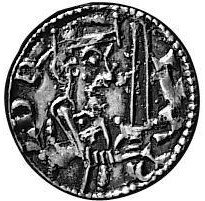Harald Hen facts for kids
Quick facts for kids Harald Hen |
|||||
|---|---|---|---|---|---|

Coin of Harald Hen
|
|||||
| King of Denmark | |||||
| Reign | 1076–1080 | ||||
| Predecessor | Sweyn II Estridsson | ||||
| Successor | Canute IV the Saint | ||||
| Born | c. 1040 | ||||
| Died | 17 April 1080 (aged 39–40) | ||||
| Burial | Dalby Church, Scania | ||||
| Spouse | Margareta Hasbjörnsdatter | ||||
|
|||||
| House | Estridsen | ||||
| Father | Sweyn II Estridsson | ||||
Harald Hen (born around 1040 – died April 17, 1080) was a King of Denmark. He ruled from 1076 to 1080. His name, "Hen," means "the Whetstone" in old Danish. Harald was a son of King Sweyn II Estridsson. He became king after his father and was known for being a peaceful ruler. Harald made several important changes during his time. He was married to his cousin, Margareta Hasbjörnsdatter. They did not have children. After Harald died, his brother, Canute IV the Saint, became king. Four of Harald's half-brothers also became kings of Denmark later on.
Contents
Harald Hen's Early Life and Rise to Power
Harald was born around the year 1040. His father was King Sweyn II. In 1069, Harald joined his father on a trip to England. His uncle, Jarl Asbjørn, and his brother, Canute, also went along.
Becoming King of Denmark
After his father, King Sweyn II, passed away in 1076, Harald wanted to become king. His younger brother, Canute, also wanted the crown. The people chose Harald to be king at a big meeting called an assembly. This meeting took place at Isøre, near Odsherred.
To become king, Harald made special promises. These promises were known as Harald's laws. He promised to follow and protect the existing laws of the land.
Harald Hen's Rule and Reforms
During his time as king, Harald faced challenges from some of his brothers. His brother Canute was likely one of them. Canute even got support from Olaf III of Norway. Pope Gregory VII stepped in to help. He told Olaf not to pick sides. The Pope also advised Harald to share power with his brothers.
Working with Nobles
Harald depended on the powerful nobles in Denmark. They helped him become king. Because of this, he did not often go against their wishes. He did not fight any big wars during his reign. Instead, he focused on improving things he could control.
Important Changes and Improvements
Harald is most famous for making Danish money better. He made sure all coins were the same and had good value. He also set up places to make coins in different cities. These cities included Ribe, Viborg, Lund, and Schleswig.
He also made royal forests open for public use. This meant people could use these forests for things like hunting or gathering wood.
Changing Old Laws
Harald also wanted to change some old Danish legal traditions. He did not like the old ways of deciding if someone was guilty. One old custom was called trial by combat. This meant two people would fight to show who was right. Another was the jernbyrd trial by ordeal. In this, a person had to hold a red-hot iron bar. If their hand healed quickly, they were innocent.
Harald brought in a new system. It was like one used in England. In this system, honest people would swear oaths. They would promise that a person was telling the truth in a trial. This helped make trials fairer.
Harald also tried to get the Pope to create a Danish Archbishopric. This would have given Denmark its own important church leader. However, he was not successful in this goal.
Harald Hen's Death and Legacy
Harald died on April 17, 1080. He was buried at Dalby Church in Scania. After his death, his brother, Canute IV, became the new king.
How People Remembered Harald
Some people had different ideas about Harald. A writer named Saxo Grammaticus thought Harald was a weak king. He felt Harald let common people control his actions. But another writer, Ælnoth, called him a "lawmaker loved by the people."
Harald was also described as a calm person. He often let others guide his decisions. This might explain his nickname, "Harald the Whetstone." A whetstone is used to sharpen things, but it is soft itself. So, "Harald the Soft" might be another way to think of his nickname.
Lasting Impact
Harald's ideas for changing laws were not fully used right away. They became more common much later. This happened during the rule of Valdemar II the Victorious in the 1200s. Some historians also question if his changes to coinage were as big as once thought.


